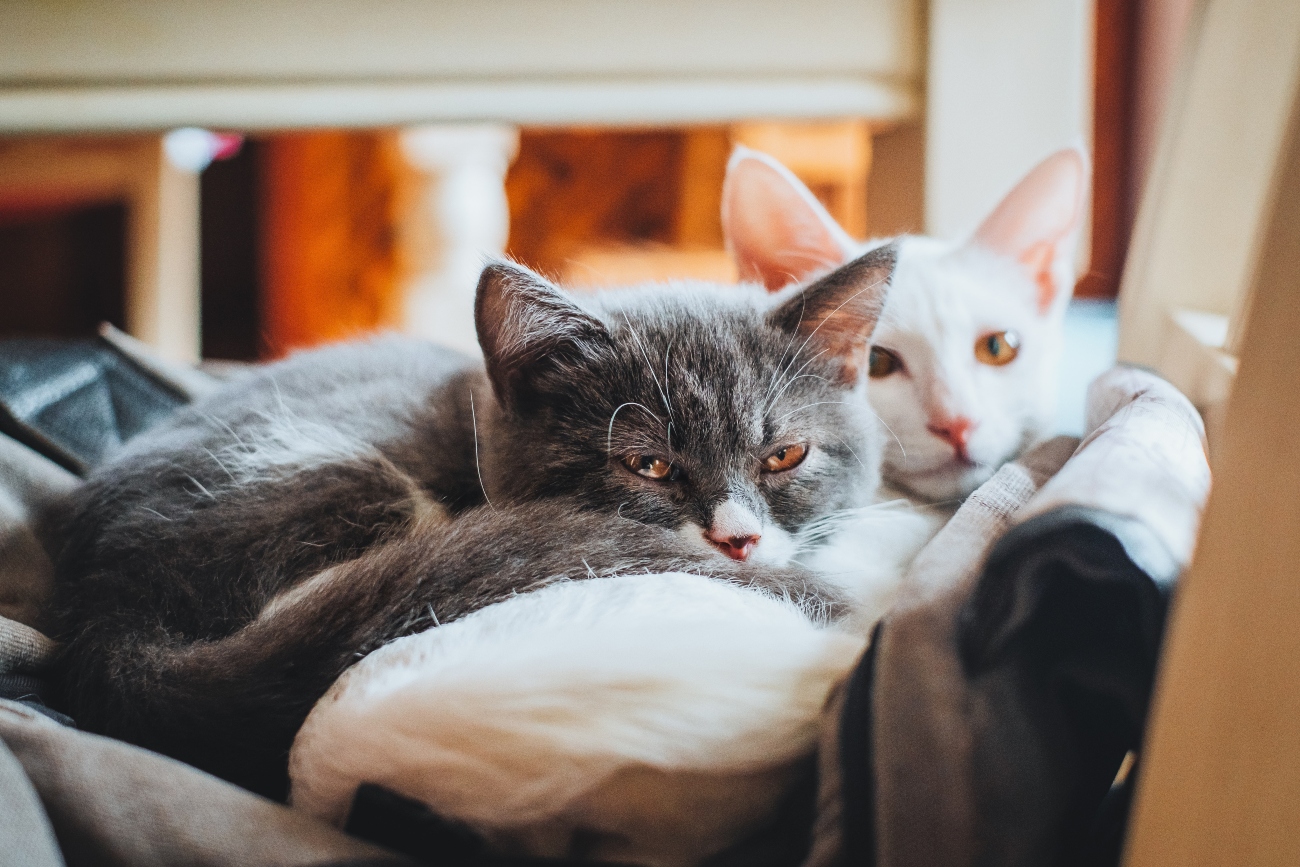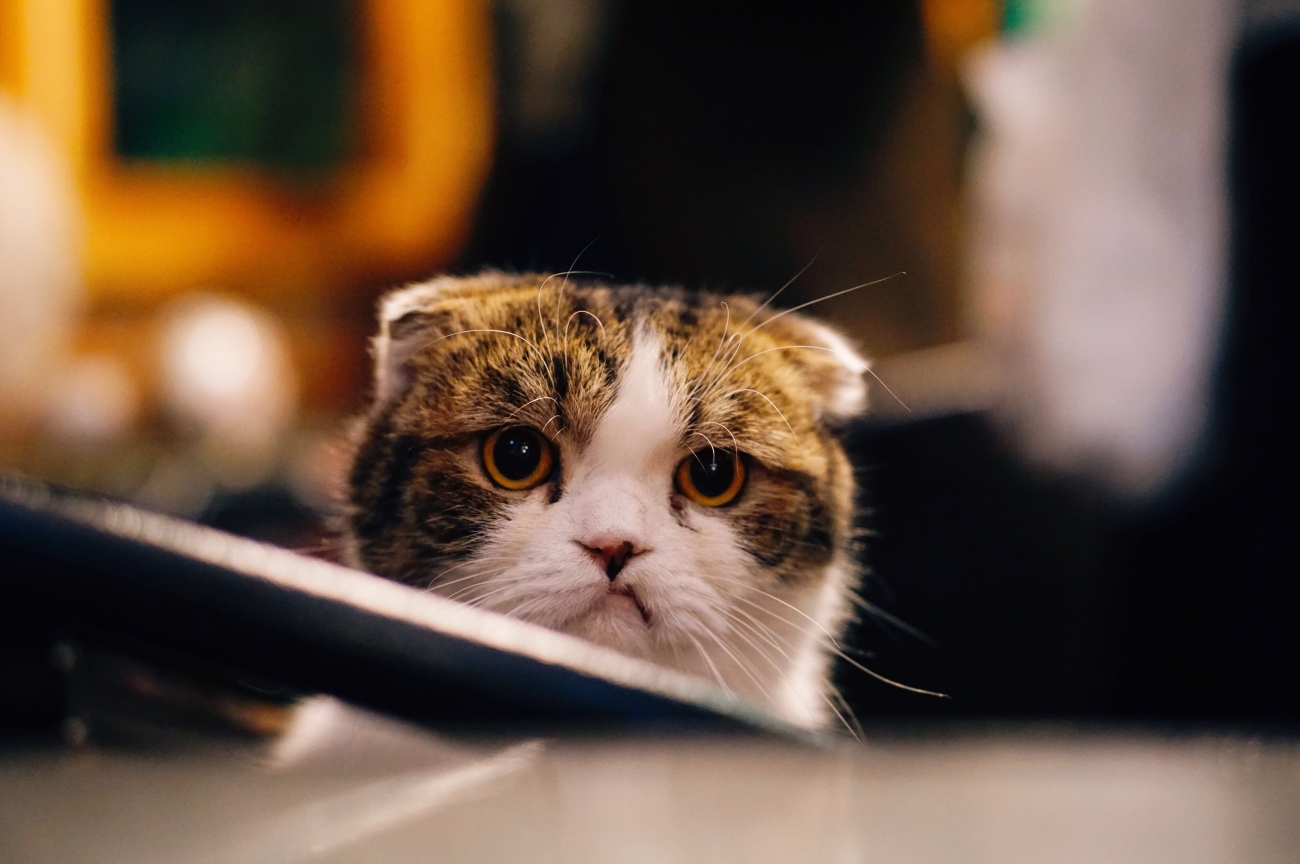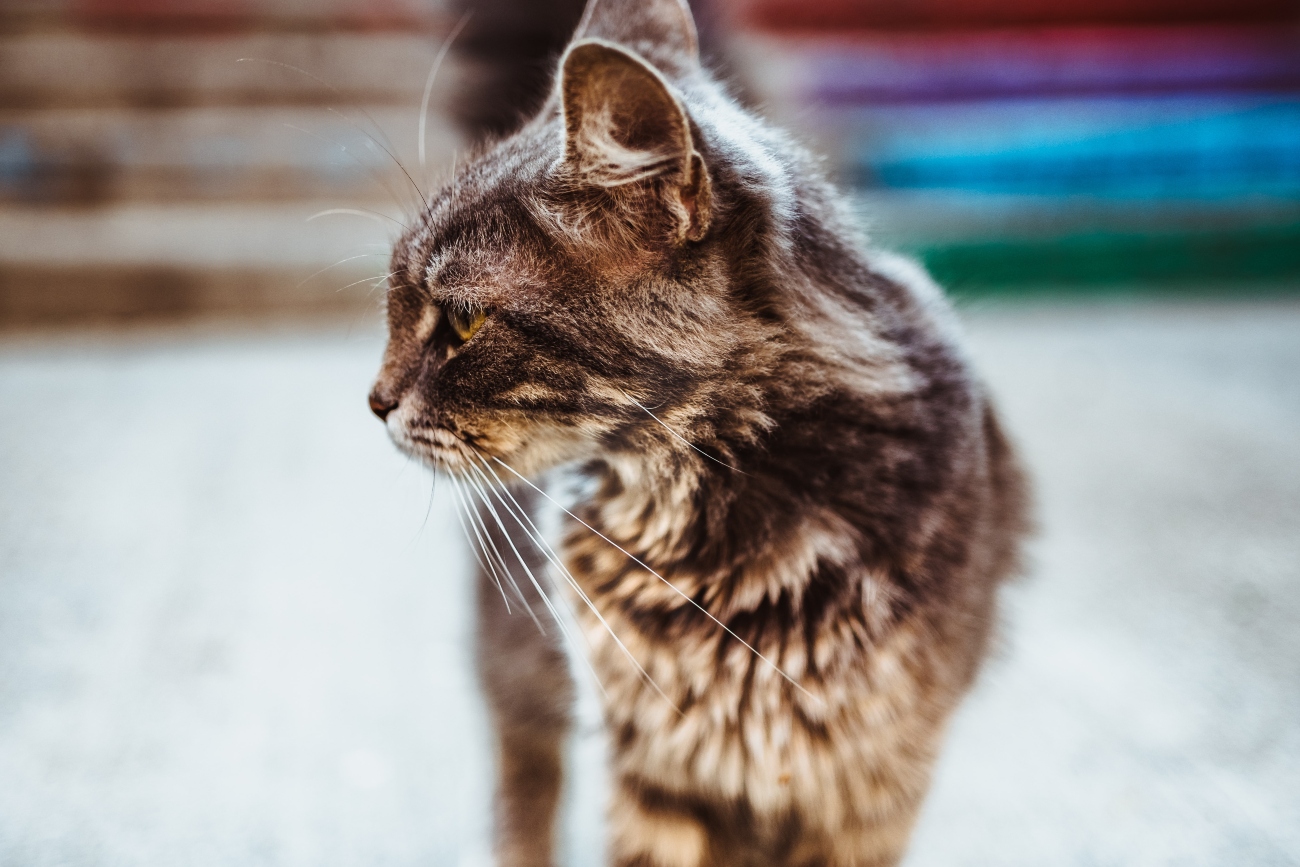
How to care for a cat with a fever
15th March, 2022
Your cat seems listless, unhappy and warm to the touch. The chances are that they have developed a fever. But how will this have come about – and what can you do to speed up their recovery? Read on as we explore in detail how to look after a cat with a fever.
The good news is that, although a raised temperature may seem alarming, in most situations your cat will return to normal fairly soon. However, it's always essential to get them seen by a vet as soon as their temperature – or, indeed, anything else about them – seems abnormal.
Our pet insurance for older cats can help towards the cost of care and our dedicated 24-Hour Vet Helpline is always on hand if you have a question about your pet’s health.

What are the signs of fever in cats?
If your cat has a fever – manifested as a high temperature – this will usually mean that something is not quite right.
Along with that elevated temperature, you may notice that your beloved feline is eating and drinking less. They may also seem to have less energy than usual. Perhaps they feel hot to touch – their ears, face and/or feet, in particular.
They may seem obviously unwell or, in a much less easily definable sense, not quite their usual cheerful self. They may hide away, seem uninterested in their food. Perhaps they are shivering and/or breathing faster than usual.
These are the chief ways in which a fever will present itself. In this article, we'll be looking at some of the possible causes for that high temperature – these can range from something pretty minor to a much more serious ailment. We'll also include some advice on what to do if your cat seems feverish.
How to take your cat’s temperature
The most accurate way to find out your cat's temperature is by inserting a thermometer into their rectum. Now, you won't be surprised to learn that many cats do not enjoy this experience, although some animals can remain calm during the procedure. Either way, it's easier to do if you have someone else on hand to help you. Digital or mercury thermometers can be used.
Your companion can help by holding your cat steadily in a standing position, so they don't wriggle around or escape. Placing your cat's head in the crook of your helper's arm is a good way to limit movement. If you're worried that your cat may unleash their claws, you may want to wrap them in a towel, keeping the tail area exposed.
If you're using a mercury thermometer, give it a good shake with a flick of your wrist to bring the mercury down below 94 degrees. Failing to do this may mean that you won't get a true reading (as the thermometer won't have been calibrated to the temperature in the room). If, on the other hand, you're using a digital thermometer, you're good to go – the thermometer will calibrate itself once it's switched on.
Next, you'll need to lubricate the thermometer with either Vaseline, petroleum jelly, KY Jelly, or another water-based lubricant. Your helper should now gently grab the base of your cat's neck while holding their front legs still.
Now, lift your cat’s tail and insert the thermometer – slowly, carefully and gently – into their rectum, which is just below where their tail meets their body. Insert it about one inch, or two centimetres, and hold it in place for a while – typically around two minutes for a mercury thermometer, or until you hear a beep in the case of a digital thermometer.
Now, remove the thermometer and read the temperature.
A cat's normal body temperature will be around 38-39 degrees Centigrade. Any higher than this, and your cat will probably start to feel unwell. They will also become notably lethargic, lacking in energy.
Make sure you clean the thermometer carefully after use. Glass thermometers are fragile, and the mercury inside is a hazardous chemical.
If this procedure sounds a little daunting, you can contact your vet for an appointment, so that they can take your animal's temperature for you.
Alternatively, you can take your cat’s temperature by placing a digital thermometer in their ear. Your cat may struggle though, and you may not be able to get such an accurate reading.
If you do decide to do it this way, hold the thermometer at a 90 degree angle to your cat’s head and don’t push it in too far. Otherwise you could damage your cat’s ear. Again, if you’re not confident doing this, ask your vet for an appointment.

What's causing your cat’s high temperature?
A fever is a specific, regulated type of hyperthermia, or raised temperature. Essentially, the fever develops when the hypothalamus, a part of the brain that acts like a thermostat for the entire body, is set to a higher temperature than normal.
But why would the hypothalamus suddenly change its settings in this way? Well, this change is usually brought about by small molecules in the blood, known as pyrogens. These can come from the external surroundings, or they can be produced within the body itself.
Infectious viruses or bacteria produce toxins that account for most external pyrogens. Internal pyrogens, on the other hand, include abnormal chemicals that are produced by tumours, as well as some proteins that are released while the immune system is working normally.
Let's look in a little more detail at the various factors that can bring about this raised temperature. They include:
A bacterial, viral, or fungal infection
Your cat may have developed a fever in order to fight infections. In this case, although the fever may seem a bad thing, it's more accurate to say that the fever itself is fighting something unwelcome. More specifically, fevers stimulate the immune system, the body's natural defence, into action. This increased bodily temperature makes life more difficult for all those infection-causing bacteria and viruses.
Infections that cause a fever in cats include ehrlichiosis, a bacterial infection carried by ticks. Alongside a high temperature, signs of this disease include swollen lymph nodes, lethargy, decreased appetite, abnormal bruising or bleeding, and eye inflammation.
Another fever-inducing infection is the so-called scratch fever, or bartonellosis. Transmissible both between animals and from animals to humans, this brings very similar symptoms to ehrlichiosis, but is usually transmitted through contact with flea faeces.
Finally, toxoplasmosis is one of the most common parasitic diseases. This is definitely one to watch out for, as accompanying symptoms include a cough, diarrhoea, breathing difficulties, jaundice, seizures, and in severe cases even death. Cats get this condition from eating infected animals, or indeed anything contaminated with faeces from an infected cat.
Treatment can be expensive, though your pet insurance for older cats may help with costs.
An abscess
On the other hand, cats (especially those given to fighting other felines) may develop painful cat bite abscesses. These usually appear on the tail, legs, face and neck, as well as on the crown of the head.
On rare occasions, bites and scratches can bring the risk of diseases such as Feline Immunodeficiency Virus (FIV) and Feline Leukaemia Virus (FeLV). This is because both teeth and claws are frequently covered in bacteria, so bites and scratches can very often lead to painful infections or abscesses.
If you think your cat has an abscess, you should not hesitate to contact your vet – not least because these bites and scratches can also cause very serious infections in humans.
Treatment will vary – some abscesses can be treated at home, while others may need veterinary attention, such as draining, flushing or surgical removal of the pus. Your pet insurance for older cats means you won’t have to delay treatment.
An unknown cause
Your cat may simply develop a pyrexia (a high temperature) whose cause seems unclear. Indeed, this type of mystery fever is sufficiently common to have its own medical designation: a 'pyrexia of unknown origin', or PUO.
This uncertainty will make the condition harder to treat successfully. It may take a little time, and several different tests before a cause is found and the correct treatment is started. Your pet insurance for older cats should be able to help with the costs of these tests. And don't worry – although in many cases the cause is never found, the high temperature often drops of its own accord within a matter of days.
Toxins
If your cat inadvertently swallows a poisonous substance – such as insecticide or a slug pellet – while out on their outdoor explorations, these can cause a high temperature, as well as muscle tremors.
Similarly, a number of foods that are perfectly safe to humans can be harmful to cats. These include chocolate, which contains theobromine, a chemical that can be fatal to felines. Dark chocolate is more dangerous than other forms here. Other foods to avoid include caffeine; onions, garlic and chives; salt, alcohol, iron in food supplements, and the sweetener xylitol.
Elsewhere around the home, all cleaning products will be extremely dangerous to your cat if consumed, even in small amounts. A number of plants are dangerous to cats too, including azalea, daffodil, rhododendron and laburnum. These are just some of a wide range of products containing harmful toxins: this useful page on the PDSA website gives you the full rundown on products and substances to keep your pet away from.
Heatstroke
We hear most often about how dogs are badly affected by the heat. However, cats are also at risk of dangerously overheating if they are stuck inside warm spaces. Flat-faced breeds such as Persian cats are particularly at risk, as are animals with thick fur.
Other at-risk types include old, very young, and overweight cats – plus animals with breathing or lung problems.
Aside from a raised temperature, other early signs of heatstroke will include heavy panting, dribbling more than usual, and possibly foaming at the mouth. A cat with heatstroke will also seem upset or distressed. There are many other reasons why an older dog may heavily pant and these can be explained on our recent blog.
As soon as you see any of these signs, you should do everything you can to help your cat to cool down – including getting them out of direct sunlight, and giving them plenty of fresh water.
Stress
If your cat feels stressed or anxious, this can raise their body temperature. Try to remove them from the source of the stress as soon as possible.
Reactions to a medicine
Certain medicines may cause a raised temperature in pets. Ask your vet if your cat’s medication might have this effect.
Obesity
Cats who are overweight will find it more difficult to lose body heat, so are more likely to overheat. Many cats may have gained weight during the pandemic: in a recent blog post on the subject, we revealed how housebound owners had been giving more human treats to their cats during this time.
Lupus
In this disease, the immune system malfunctions and becomes hyperactive, resulting in various symptoms including a raised temperature. The disease seems rare in cats, though it's thought to be under-diagnosed.
As with humans, lupus in cats exists in two forms: discoid lupus (DLE) and systemic lupus (SLE). Both forms can cause damage to various bodily organs, and both can be fatal without treatment. Persian, Siamese, and Himalayan cat breeds appear to be more at risk of SLE than other cat breeds.
When should you contact your vet?
You should speak to your vet as soon as your cat develops a high temperature, or demonstrates any of the other symptoms we mentioned above – listlessness, eating or drinking less, hiding and so on.
This is important because, although the cause of the fever is often something relatively minor, it can sometimes be the start of something more serious which will require urgent treatment. What's more, your cat won't be comfortable in this feverish state, while their diminished appetite could itself become a problem for them if not resolved quickly.

How do you treat a high temperature in cats?
Exactly how a high temperature, or fever, is treated will depend entirely on what has caused it in the first place. What we can safely say is that, if at any point your cat shows a temperature above 40 degrees Celsius, you should get them seen by a vet as soon as possible.
Once you get to the vet, they will probably want to conduct some tests to ascertain the exact cause of the fever, and to start to treat that underlying case. By the way, we would recommend bringing along your cat's vaccination record when you visit the vet. This will help the vet to get a precise picture of which diseases your pet has not been vaccinated against, and this in turn will help them narrow down the cause of the fever.
From here on, the options will vary. If, for example, it seems that the elevated temperature has been caused by a bacterial infection, the obvious route to go down will be a course of antibiotics. We'll go into antibiotics, and how they are administered, in a little more detail in the next section.
On the other hand, if your cat has suffered a bout of dehydration, either moderate or severe, treatment will be via intravenous or subcutaneous fluids. The difference? Well, the former are injected into the vein, while the latter pass into the fatty tissue just under the skin.
If subcutaneous fluids are deemed to be the best option, you may be given a 'drip bag' containing the fluid, plus a length of 'drip tubing'. The latter is attached to a needle, which is placed under the skin for rapid fluid intake. This might sound painful and uncomfortable, but in fact most cats cope well with being given fluids in this manner. As each fluid intake typically takes a few minutes, it's often a good idea to cuddle or stroke your cat during this time, to comfort and distract them. Food will be another welcome distraction!
How you can help
After a fever, your cat is likely to need plenty of rest and hydration. Make sure that they have plenty of fresh water available and, if there are children in the household, encourage them to leave the family pet in peace during this time.
If your vet has prescribed antibiotics, do make sure your cat completes the course. Not finishing the course will mean that the antibiotics won't work effectively, and the bacteria that they are fighting may develop and even spread. It may be difficult to get your cat to take medication – but do persevere.
One often convenient option for giving medication is to disguise it in food. After all, pet medicines are most commonly prescribed as tablets or pills. The chances are that your cat will turn their nose up at the pill in solid form: however, if you crush it into their food, you should be able to smuggle it into them that way!
Simply break up the tablet(s) into a small portion of their food: the very start of mealtime is best for this, when your pet is still hungry and will eat without hesitating.
You might even decide to keep them off food for the previous 12 hours, so that they're starving and ready to eat when the time comes. You may want to hide the medication in one of their favourite treats: try 'pill pockets' – hollow treats that you can stash the medicine inside and then reseal.
Just check with your vet that this particular tablet is suitable for crushing into food, as certain medicines may not be as effective when crushed. Others must be given on an empty stomach in order to work properly.
Finally, if it's proving a struggle to get your cat to take its medication in solid form, it's definitely worth asking your vet whether there's a liquid option on the market. Liquid medication can often be easier to give to pets.
We've got some more detailed advice on giving medicine to cats in our article, How to give an older cat medication.
A word of warning: you should never give your cat any medication without consulting a vet first. This is because certain medications like paracetamol are toxic to cats.
Customers of our pet insurance for older cats here at Petwise will be able to call our 24-Hour Vet Helpline, free of charge, for advice on this and many other matters.
Prevention is better than cure
Sometimes, you may be able to catch signs of a developing fever before things get too serious or uncomfortable for your kitty. It's a good idea to undertake a regular cat maintenance session – including brushing their teeth, clipping their claws, checking inside the ears as well as monitoring their eating and drinking habits. All of these things will give you valuable information about their overall state of health and what normal looks like for them.
Pet insurance for older cats: one of the best forms of care
Life with a cat contains so many moments of joy, companionship and affection. It also means looking after this special furry friend in your life, to the very best of your abilities.
Taking out some specialist pet insurance for older cats can really help with this. Benefits of our insurance policies here at Petwise include:
- Senior food contribution
- Direct payment to vets
- No upper age joining limit
Why not contact us today to arrange some pet insurance for older cats?